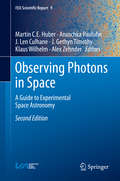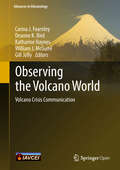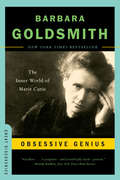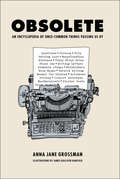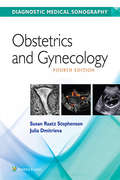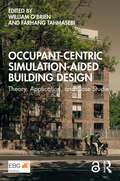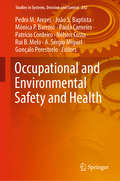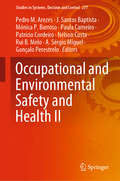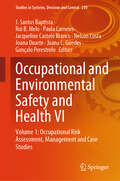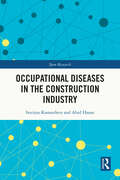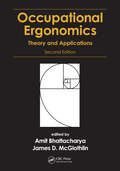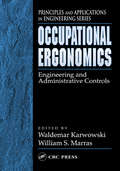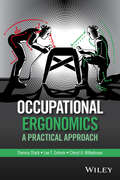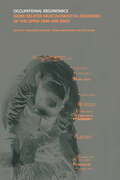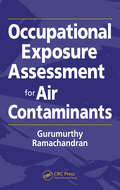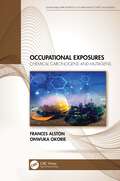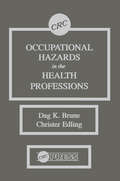- Table View
- List View
Observing Our Environment from Space - New Solutions for a New Millennium: Proceedings of the 21st EARSel Symposium, Paris, France, 14-16 May 2001
by Gérard BégniThis work reflects preoccupations with the threats posed to our environment due to climatic factors, major and natural hazards of all kinds and demographic influences. Topics covered include land surface processes, coastal zones and atmospheric risks.
Observing Photons in Space
by Martin C. E. Huber Anuschka Pauluhn J. Len Culhane J. Gethyn Timothy Klaus Wilhelm Alex ZehnderAn ideal resource for lecturers, this book provides a comprehensive review of experimental space astronomy. The number of astronomers whose knowledge and interest is concentrated on interpreting observations has grown substantially in the past decades; yet, the number of scientists who are familiar with and capable of dealing with instrumentation has dwindled. All of the authors of this work are leading and experienced experts and practitioners who have designed, built, tested, calibrated, launched and operated advanced observing equipment for space astronomy. This book also contains concise information on the history of the field, supported by appropriate references. Moreover, scientists working in other fields will be able to get a quick overview of the salient issues of observing photons in any one of the various energy, wavelength and frequency ranges accessible in space. This book was written with the intention to make it accessible to advanced undergraduate and graduate students.
Observing the Volcano World: Volcano Crisis Communication (Advances in Volcanology)
by Carina J. Fearnley Deanne K. Bird Katharine Haynes William J. McGuire Gill JollyThis open access book provides a comprehensive overview of volcanic crisis research, the goal being to establish ways of successfully applying volcanology in practice and to identify areas that need to be addressed for future progress. It shows how volcano crises are managed in practice, and helps to establish best practices. Consequently the book brings together authors from all over the globe who work with volcanoes, ranging from observatory volcanologists, disaster practitioners and government officials to NGO-based and government practitioners to address three key aspects of volcanic crises. First, the book explores the unique nature of volcanic hazards, which makes them a particularly challenging threat to forecast and manage, due in part to their varying spatial and temporal characteristics. Second, it presents lessons learned on how to best manage volcanic events based on a number of crises that have shaped our understanding of volcanic hazards and crises management. Third, it discusses the diverse and wide-ranging aspects of communication involved in crises, which merge old practices and new technologies to accommodate an increasingly challenging and globalised world. The information and insights presented here are essential to tapping established knowledge, moving towards more robust volcanic crises management, and understanding how the volcanic world is perceived from a range of standpoints and contexts around the globe.
Obsessive Genius: The Inner World of Marie Curie (Great Discoveries)
by Barbara GoldsmithThrough family interviews, diaries, letters, and workbooks that had been sealed for over sixty years, Barbara Goldsmith reveals the Marie Curie behind the myth--an all-too-human woman struggling to balance a spectacular scientific career, a demanding family, the prejudice of society, and her own passionate nature. Obsessive Genius is a dazzling portrait of Curie, her amazing scientific success, and the price she paid for fame. The best-selling, "excellent . . . poignant--and scientifically lucid-- portrait" (New York Times Book Review) of the remarkable Marie Curie.... "Never a dull moment. . . . Goldsmith leads the reader through a wonderland of facts with just the right blend of science and story. In the end, the mystery of the great Madame [Curie] remains, but a deeper understanding of what she went through as a woman and a scientist shines as strong as her radium."--San Francisco Chronicle "Bestselling historian Goldsmith incisively chronicles [Curie's] intensely dramatic life. . . . Her powerful portrait reveals a woman of great passion, genius, and pain who changed the world."--Booklist, starred review
Obsolete: An Encyclopedia of Once-Common Things Passing Us By
by Anna Jane GrossmanA cultural catalog of everyday things rapidly turning into rarities—from landlines to laugh tracks. So many things have disappeared from our day-to-day world, or are on the verge of vanishing. Some we may already think of as ancient relics, like typewriters (and their accompanying bottles of correction fluid). Others seem like they were here just yesterday, like boom boxes and CDs. We may feel fond nostalgia for certain items of yore: encyclopedias, newspapers, lighthouses. Other items, like MSG, not so much. But as the pace of change keeps accelerating, it&’s worth taking a moment to mark the passing of the objects of our lives, from passbooks and pay phones to secretaries and skate keys. And to reflect on certain endangered phenomena that may be worth trying to hold on to—like privacy, or cash. This thoughtful alphabetized compendium invites us to take a look at the many things, ideas, and behaviors that have gone the way of the subway token—and to reflect on what is ephemeral, and what is truly timeless.
Obstetrics & Gynecology: A Guide To Clinical Practice, Obstetrics And Gynecology (Diagnostic Medical Sonography Series)
by Susan Stephenson Julia DmitrievaThe updated Diagnostic Medical Sonography Series, which includes new editions of Diagnostic Medical Sonography: Abdomen and Superficial Structures, Diagnostic Medical Sonography: Obstetrics and Gynecology, and Diagnostic Medical Sonography: The Vascular System, provides the right content at the right level for the right way to teach and learn. The updated 4th Edition of Stephenson’s Diagnostic Medical Sonography: Obstetrics and Gynecology offers the most in-depth, current, and consistent coverage of this crucial sonography topic available today.
Occupant-Centric Simulation-Aided Building Design: Theory, Application, and Case Studies
by William O’Brien Farhang TahmasebiOccupant-Centric Simulation-Aided Building Design promotes occupants as a focal point for the design process. This resource for established and emerging building designers and researchers provides theoretical and practical means to restore occupants and their needs to the heart of the design process. Helmed by leaders of the International Energy Agency Annex 79, this edited volume features contributions from a multi-disciplinary, globally recognized team of scholars and practitioners. Chapters on the indoor environment and human factors introduce the principles of occupant-centric design while chapters on selecting and applying models provide a thorough grounding in simulation-aided building design practice. A final chapter assembling detailed case studies puts the lessons of the preceding chapters into real-world context. In fulfillment of the International Energy Agency’s mission of disseminating research on secure and sustainable energy to all, Occupant-Centric Simulation-Aided Building Design is available as an Open Access Gold title. With a balance of fundamentals and design process guidelines, Occupant-Centric Simulation-Aided Building Design reorients the building design community toward buildings that recognize and serve diverse occupant needs, while aiming for superior environmental performance, based on the latest science and methods.
Occupational and Environmental Safety and Health (Studies in Systems, Decision and Control #202)
by Pedro M. Arezes João S. Baptista Mónica P. Barroso Paula Carneiro Patrício Cordeiro Nélson Costa Rui B. Melo A. Sérgio Miguel Gonçalo PerestreloThis book explores a number of important issues in the area of occupational safety and hygiene. Presenting both research and best practices for the evaluation of occupational risk, safety and health in various types of industry, it particularly focuses on occupational safety in automated environments, innovative management systems and occupational safety in a global context. The different chapters examine the perspectives of all those involved, such as managers, workers and OSH professionals. Based on selected contributions presented at the 15th International Symposium on Occupational Safety and Hygiene (SHO 2019), held on 15–16 April, 2019, in Guimarães, Portugal, the book serves as a timely reference guide and source of inspiration to OSH researchers, practitioners and organizations operating in a global context.
Occupational and Environmental Safety and Health II (Studies in Systems, Decision and Control #277)
by Pedro M. Arezes Paula Carneiro Patrício Cordeiro Rui B. Melo Gonçalo Perestrelo Mónica P. Barroso Nélson Costa A. Sérgio Miguel J. Santos BaptistaThis book explores a number of important issues in the area of occupational safety and hygiene. Presenting both research and best practices for the evaluation of occupational risk, safety and health in various types of industry, it particularly focuses on occupational safety in automated environments, innovative management systems and occupational safety in a global context. The different chapters examine the perspectives of all those involved, such as managers, workers and OSH professionals. Based on selected contributions presented at the 16th International Symposium on Occupational Safety and Hygiene (SHO 2020), held on 6–7 April, 2020, in Porto, Portugal, the book serves as a timely reference guide and source of inspiration to OSH researchers, practitioners and organizations operating in a global context.
Occupational and Environmental Safety and Health III (Studies in Systems, Decision and Control #406)
by Pedro M. Arezes Paula Carneiro Rui B. Melo Gonçalo Perestrelo Nélson Costa A. Sérgio Miguel J. Duarte J. Santos Baptista Jacqueline Castelo Branco J. C. GuedesThis book gathers cutting-edge research and best practices relating to occupational risk and safety management, healthcare and ergonomics. It covers strategies for different types of industry, such as construction, food, chemical and healthcare. It gives a special emphasis on challenges posed by automation, discussing solutions offered by technologies, and reporting on case studies carried out in different countries. Chapters are based on selected contributions to the 17th International Symposium on Occupational Safety and Hygiene (SHO 2021), held virtually on November 17–19, 2021, from Portugal. By reporting on different perspectives, such as the ones from managers, workers and OSH professionals, and covering timely issues, such as safety evaluation of human-robot collaboration, this book offers extensive information and a source of inspiration to OSH researchers, practitioners and organizations operating in both local and global contexts.
Occupational and Environmental Safety and Health IV (Studies in Systems, Decision and Control #449)
by Pedro M. Arezes J. Santos Baptista Rui B. Melo Jacqueline Castelo Branco Paula Carneiro Ana Colim Nélson Costa Susana Costa J. Duarte J. C. Guedes Gonçalo PerestreloThis book gathers cutting-edge research and best practices relating to occupational risk and safety management, healthcare and ergonomics. It covers strategies for different industries, such as construction, chemical and healthcare. It emphasises challenges posed by automation, discusses solutions offered by technologies, and reports on case studies carried out in different countries. Chapters are based on selected contributions to the 18th International Symposium on Occupational Safety and Hygiene (SHO 2022), held on September 8–9, 2022, in Porto, Portugal. By reporting on different perspectives, such as the ones from managers, workers and OSH professionals, and covering timely issues, such as implications of telework ,issues related to gender inequality and applications of machine learning techniques in occupational health, this book offers extensive information and a source of inspiration to OSH researchers, practitioners and organizations operating in both local and global contexts.
Occupational and Environmental Safety and Health V (Studies in Systems, Decision and Control #492)
by Pedro M. Arezes Rui B. Melo Paula Carneiro Jacqueline Castelo Branco Ana Colim Nélson Costa Susana Costa Joana Duarte Joana C. Guedes Gonçalo Perestrelo J. Santos BaptistaThis book gathers cutting-edge research and best practices relating to occupational risk and safety management, healthcare, and ergonomics. It covers strategies for different industries, such as construction, chemical and healthcare. It emphasizes challenges posed by automation, discusses solutions offered by technologies, and reports on case studies carried out in different countries. Chapters are based on selected contributions to the 20th International Symposium on Occupational Safety and Hygiene (SHO 2023), held on July 20-21, 2023, in Portugal, as a hybrid event. By reporting on different perspectives, such as the ones from managers, employees, and OSH professionals, and covering timely issues, such as implications of telework, issues related to gender inequality and applications of machine learning techniques in occupational health, this book offers extensive information and a source of inspiration to OSH researchers, practitioners and organizations operating in both local and global contexts.
Occupational and Environmental Safety and Health VI: Volume 1: Occupational Risk Assessment, Management and Case Studies (Studies in Systems, Decision and Control #230)
by J. Santos Baptista Rui B. Melo Paula Carneiro Jacqueline Castelo Branco Nelson Costa Joana Duarte Joana C. Guedes Gonçalo PerestreloThis book gathers cutting-edge research and best practices relating to occupational risk and safety management, healthcare, and ergonomics. It covers strategies for different industries, such as construction, chemical, and healthcare. It emphasizes challenges posed by automation, discusses solutions offered by technologies, and reports on case studies carried out in different countries. Chapters are based on selected contributions to the 21st International Symposium on Occupational Safety and Hygiene (SHO 2024), held on July 4-5, 2024, in Porto, Portugal. By reporting on different perspectives, such as the ones from managers, employees, and OSH professionals, and covering timely issues, such as implications of telework, issues related to gender inequality and applications of machine learning techniques in occupational health, this book offers extensive information and a source of inspiration to OSH researchers, practitioners, and organizations operating in both local and global contexts. This is the first volume of a 2-volume set.
Occupational Audiometry
by Maryanne MaltbyThe EU Physical Agents Directive on Noise, which will be implemented into UK law in February 2006, will reduce noise action levels drastically. Under the new regulations, many more industries, which have so far not been associated with high noise levels such as restaurants and call centres, will have to assess the noise levels in their businesses and monitor their employees’ hearing according to HSE guidelines.This practical guide gives occupational health nurses everything they need to know about setting up and managing hearing conservation programmes, as well as how to carry out the audiometric tests. The text fully covers the syllabus of BSA accredited courses for the certificate of competence in Industrial Audiometry and includes practical examples, case studies, sample audiograms and questionnaires for setting up case histories. As the BSA syllabus is based on the HSE’s guidelines, the book will be a useful training manual and up-to-date reference for Health and Safety professionals, Occupational Health professionals, and HSE inspectors.Dr Maryanne Maltby is an Audiological Scientist and Principal Lecturer on the Amplivox courses in Industrial Audiometry. She has previously taught Audiology and related subjects at Manchester University (Course Leader) and at Oxford Brookes University. She is a committee member of the Hearing Aid Council and a member of the British Society of Audiology. She also has wide consultancy experience in workplace training and advice on hearing conservation issues, fitting hearing protection, management of hearing and tinnitus problems at work.
Occupational Diseases in the Construction Industry (ISSN)
by Imriyas Kamardeen Abid HasanDespite occupational diseases in construction contributing to a significant proportion of fatalities, and permanent and temporary incapacities, they have not gained as much attention as occupational injuries from practitioners and researchers. The research in this book aims to discover occupational diseases that cause fatalities and permanent and temporary incapacities in the construction industry, along with their epidemiological causal mechanisms.Through chapters examining cancers, circulatory system diseases, respiratory system diseases, nervous system and sense organ diseases, and musculoskeletal diseases, the authors provide new knowledge and insights to help proactively prevent and control these diseases. The research underpinning the development of the book applies empirical analyses of real-world occupational disease data for the construction industry alongside a detailed review and meta-analysis of literature pertinent to risk factors and methods and strategies to prevent and/or control occupational diseases in construction.Knowing the riskiest diseases and occupations for construction workers, along with organisational and personal risk factors, is critical to optimising risk management efforts. This book should be of interest to students, researchers, and practitioners in construction management, occupational health and safety, and risk management.
Occupational Ergonomics: Theory and Applications, Second Edition
by Amit Bhattacharya James D. McGlothlinIn the fifteen years since the publication of Occupational Ergonomics: Theory and Applications significant advances have been made in this field. These advances include understanding the impact of ageing and obesity on workplace, the role of ergonomics in promoting healthy workplaces and healthy life styles, the role of ergonomic science in th
Occupational Ergonomics: Engineering and Administrative Controls
by Waldemar Karwowski William S. MarrasOccupational Ergonomics: Engineering and Administrative Controls focuses on prevention of work-related musculoskeletal disorders with an emphasis on engineering and administrative controls. Section I provides knowledge about risk factors for upper and lower extremities at work, while Section II concentrates on risk factors for work-related low back
Occupational Ergonomics: Principles of Work Design
by Waldemar Karwowski William S. MarrasOccupational Ergonomics: Principles of Work Design focuses on the fundamentals in ergonomics design and evaluation. Divided into two parts, Part I covers the background for the discipline and profession of ergonomics and offers an international perspective on ergonomics. Part II describes the foundations of ergonomics knowledge, including fundament
Occupational Ergonomics: Design and Management of Work Systems (Principles and Applications in Engineering)
by Waldemar Karwowski William S. MarrasOccupational Ergonomics: Design and Management of Work Systems comprises chapters carefully selected from CRC's bestselling Occupational Ergonomics Handbook, logically organized for optimum convenience and thoughtfully priced to fit every budget. This book presents 34 chapters addressing selected issues in the area of occupational macroergonomics,
Occupational Ergonomics: A Practical Approach
by Lee T. Ostrom Theresa Stack Cheryl A. WilhelmsenThe approach to the book is analogous to a toolkit. The user will open the book and locate the tool that best fits the ergonomic assessment task he/she is performing. The chapters of the book progress from the concept of ergonomics, through the various assessment techniques, and into the more complex techniques. In addition to discussing the techniques, this book presents them in a form that the readers can readily adapt to their particular situation. Each chapter, where applicable, presents the technique discussed in that chapter and demonstrates how it is used. The supporting material at the end of each chapter contains exercises, case studies and review questions. The case study section of the book presents how to use techniques to analyze a range of workplace scenarios. Topics include: The Basics of Ergonomics; Anthropometry; Office Ergonomics; Administrative Controls; Biomechanics; Hand Tools; Vibration; Workstation Design; Manual Material Handling; Job Requirements and Physical Demands Survey; Ergonomic Survey Tools; Work-related Musculoskeletal Disorders; How to Conduct an Ergonomics Assessment; and Case Studies
Occupational Ergonomics: A Practical Approach
by Theresa Stack Lee T. OstromOCCUPATIONAL ERGONOMICS Develop a healthier connection between worker and work with this practical introduction The United States Bureau of Labor Statistics estimates that 34% of all workdays lost each year are the result of work-related musculoskeletal disorders (WMSDs). These disorders result from a mismatch between a worker, their working conditions, and the task they perform. Improperly designed tasks or equipment, insufficient downtime between shifts or tasks, or even simple sitting position can all produce WMSDs. The key insights into preventing these disorders are produced by ergonomics, the scientific study of human bodies as they relate to objects, systems, and environments, especially work environments. Occupational Ergonomics: A Practical Approach aims to supply an ergonomic toolkit for creating healthier relationships between workers’ bodies and their work. Beginning with a set of foundational ergonomic principles, it then details multiple assessment techniques in ways easily adapted to specific workplace situations. This balance of theory and practice has made Occupational Ergonomics an essential reference concerning human beings and the work they do. Readers of the second edition will also find: Up-to-date ergonomic research reflecting the latest clinical and workplace data Entirely new chapters on Work Physiology, Total Worker Health, Return on Investment, and more Major revisions to chapters on Elements of an Ergonomic Program, Workstation Design, Work-Related MSDs, How to Conduct an Assessments, and Office Ergonomics Detailed and updated case studies applying ergonomic assessment techniques to common workplace scenarios Occupational Ergonomics is a must for workplace safety managers, safety coordinators, ergonomics program coordinators, facilities managers, and any professionals concerned with the work environment, and worker health and safety.
Occupational Ergonomics: Work Related Musculoskeletal Disorders of the Upper Limb and Back
by Francesco Violante Thomas Armstrong Åsa KilbomWork related musculoskeletal disorders (WRMSDs) are the leading cause of worker impairment, disability, compensation costs and loss of productivity in industrialized countries. The aging of the workforce and the increased diffusion of physically demanding jobs contribute to the widespread concern about musculoskeletal disorders.The effective pr
Occupational Exposure Assessment for Air Contaminants
by Gurumurthy RamachandranAddressing occupational exposure assessment for air contaminants as a coherent body of knowledge, this is the first book to explore occupational air contaminant measurement and properties, human exposure assessment, design of exposure strategies, and the statistical interpretation of exposure measurements in one comprehensive source. The book covers both the technological aspects of measuring air contaminants and the occupational hygiene framework within which such measurements take place. The all-inclusive exploration of the major theories and practices of occupational exposure assessment for air contaminants make this an ideal textbook for graduate or upper-level undergraduate courses.
Occupational Exposures: Chemical Carcinogens and Mutagens (Sustainable Improvements in Environment Safety and Health)
by Frances Alston Onwuka OkorieOccupational Exposures: Chemical Carcinogens and Mutagens offers a focused emphasis on chemical exposures associated with carcinogenic and mutagenic impacts along with associated controls for mitigating and controlling exposures. It discusses a range of topics including hematopoietic system impact, reproductive system impact, inorganic compounds, halogenated compounds, carbamates, polycyclic aromatic hydrocarbons, aromatic amines, product elimination and substation, exposure control methods, and human biological impact. Presents a comprehensive account of carcinogens and mutagens for occupational and environmental health professionals Covers preventive measures and controls for carcinogens and mutagens Discusses exposure controls, exposure pathways, impacts, and treatments The book is ideal for professionals and graduate students in the fields of occupational health and safety, industrial engineering, and chemical engineering.
Occupational Hazards in the Health Professions
by Dag K. Brune Christer EdlingThis volume is written especially for health professionals affiliated with hospitals, veterinary clinics, dental offices, dental laboratories, toxicological testing laboratories, and pharmaceutical laboratories as a contribution to attain security in such working environments. Possible hazards in the working environments for the health professionals are discussed, followed by recommendations of the various precautions that may be taken to avoid these hazards. The possible hazards in hospitals discussed are ergonomics, physical hazards, chemical hazards, and bacteriological risks. The ergonomics, chemical hazards, and bacteriological risks for dental offices and veterinary clinics are also explained.

